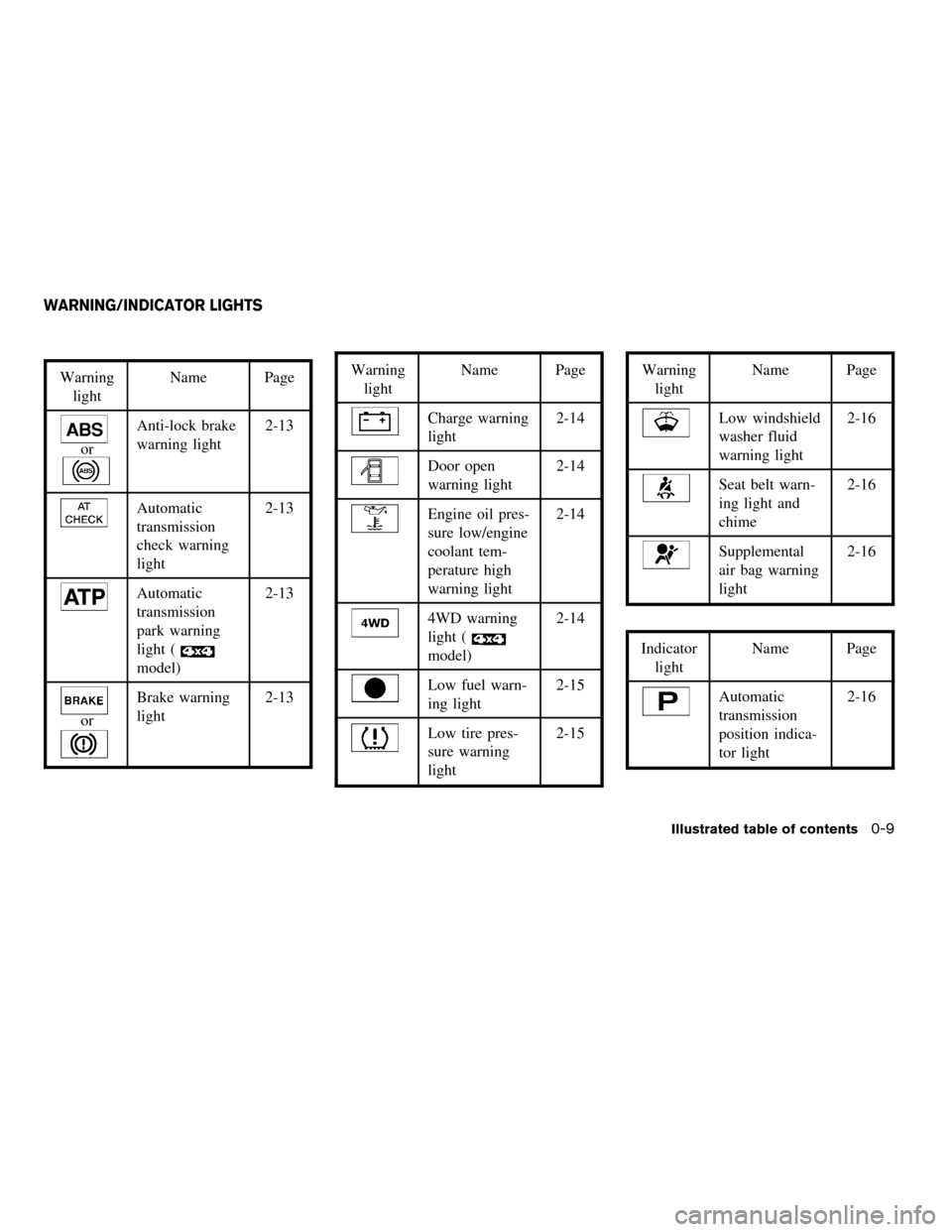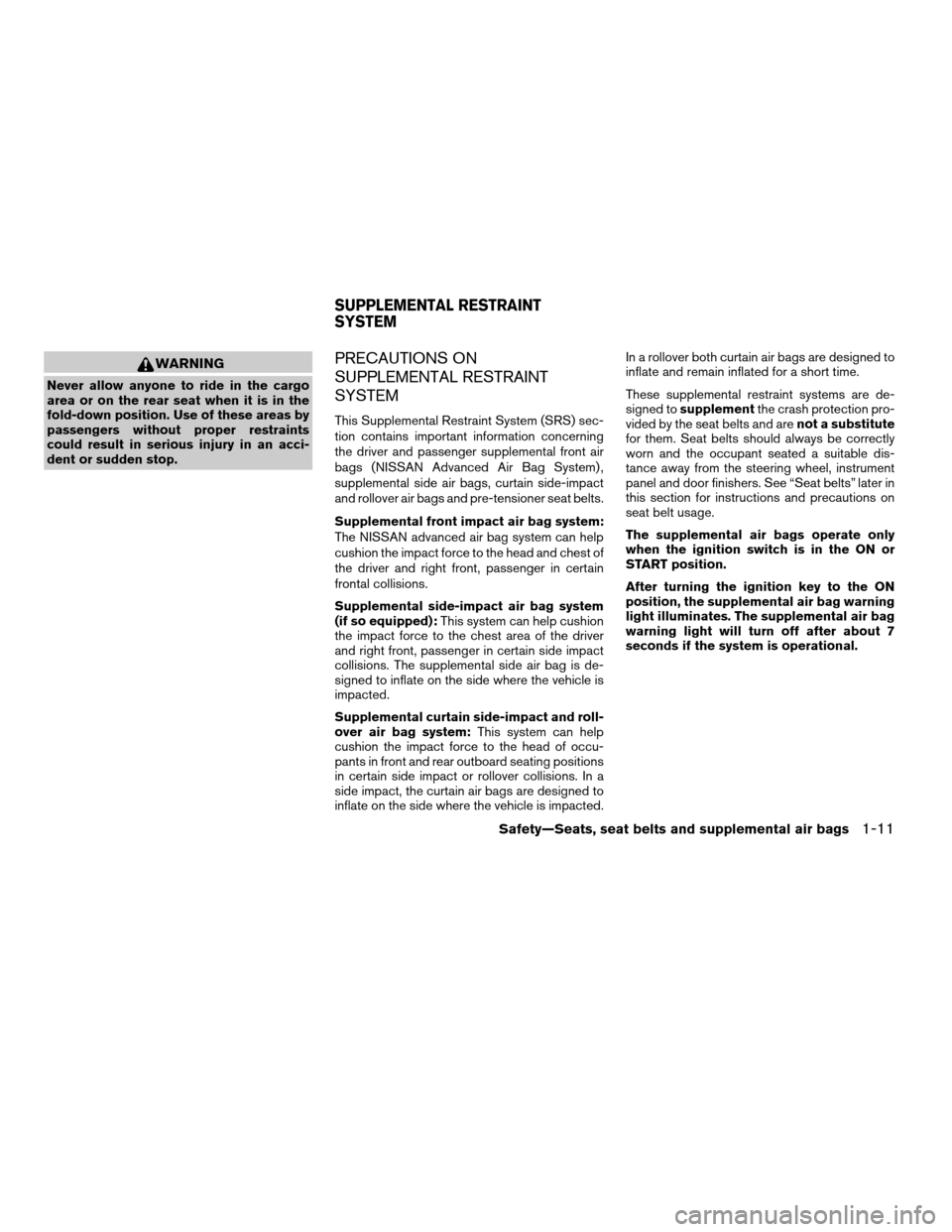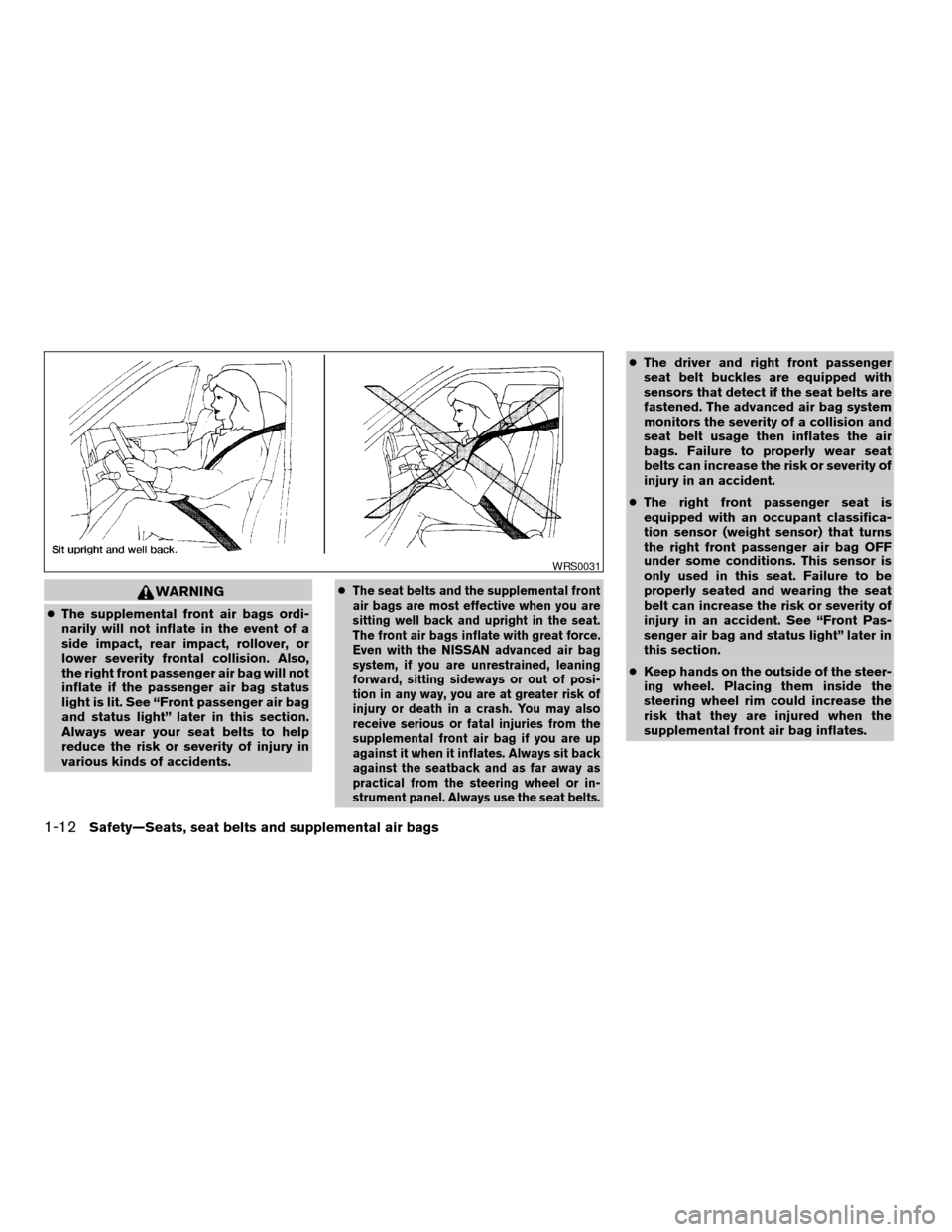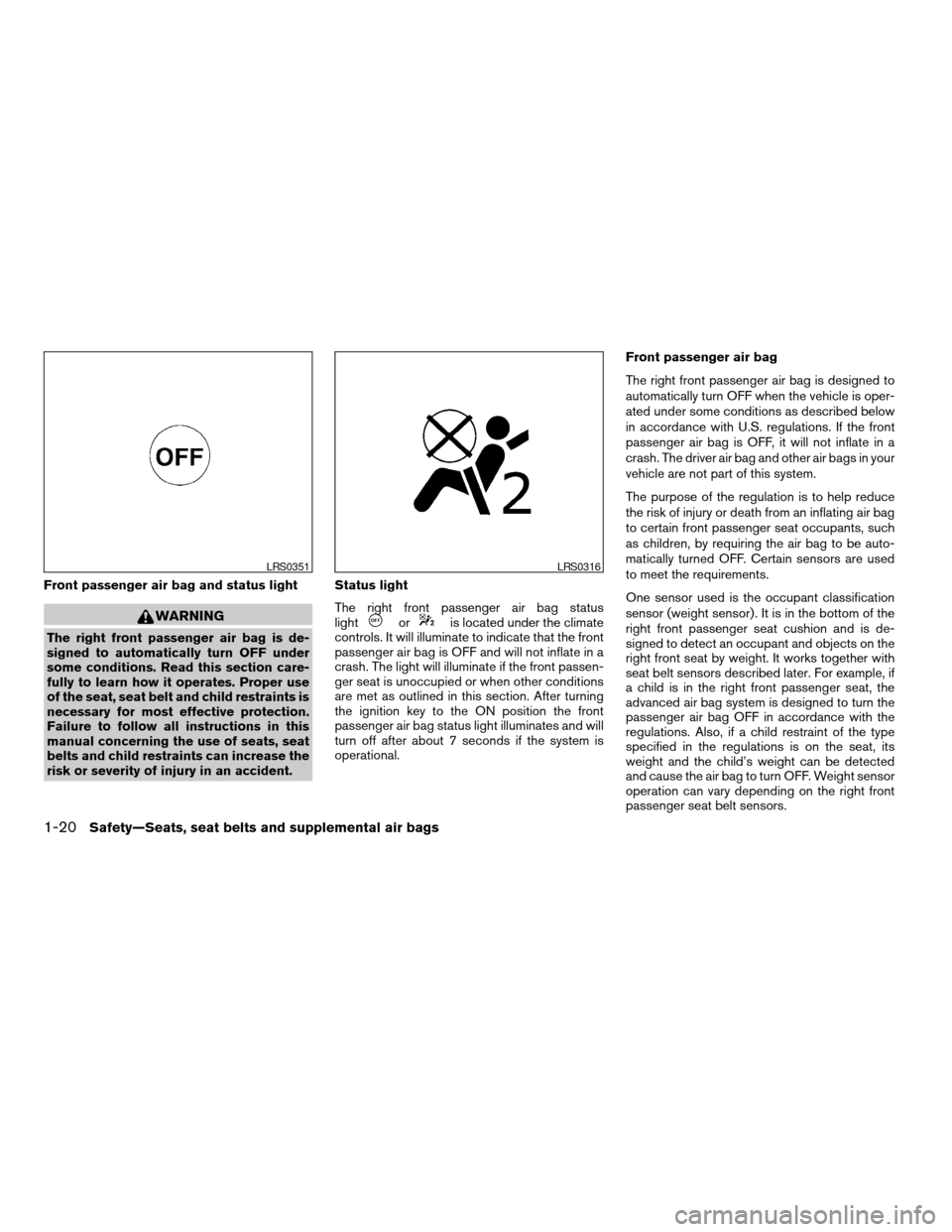2004 NISSAN TITAN warning light
[x] Cancel search: warning lightPage 7 of 328

0 Illustrated table of contents
Airbags, seat belts and child restraints...............0-2
Exterior front......................................0-3
Exterior rear.......................................0-4
Passenger compartment...........................0-5Instrument panel...................................0-6
Engine compartment locations......................0-8
Warning/indicator lights............................0-9
ZREVIEW COPY:Ð2004 Titan(tzw)
Owners Manual(owners)ÐUSA English(nna)
02/23/04Ðdebbie
X
Page 12 of 328

1. Driver, center and passenger vents
(P. 4-11)
2. Instrument brightness control (P. 2-26)
3. Headlight and turn signal switch
(P. 2-23)
4. Steering wheel switch for audio control
(if so equipped) (P. 4-36)
5. Driver supplemental air bag/horn
(P. 1-11, P. 2-28)
6. Meters, gauges and warning/indicator
lights (P. 2-3, 2-12)
7. Cruise control main/set switches
(if so equipped) (P. 5-17)
8. Windshield wiper/washer switch
(P. 2-22)
9. Ignition switch (P. 5-7)
10. Navigation system* (if so equipped)
(P. 4-2)
11. Navigation system* controls (if so
equipped) (P. 4-2)
12. Audio system controls (P. 4-19)
13. Front passenger supplemental air bag
(P. 1-11)
14. Glove box (P. 2-37)
15. Climate controls (P. 4-12)
16. Aux jack (P. 4-35)
WIC0730
INSTRUMENT PANEL
0-6Illustrated table of contents
ZREVIEW COPY:Ð2004 Titan(tzw)
Owners Manual(owners)ÐUSA English(nna)
02/20/04Ðtbrooks
X
Page 15 of 328

Warning
lightName Page
or
Anti-lock brake
warning light2-13
Automatic
transmission
check warning
light2-13
Automatic
transmission
park warning
light (
model)2-13
or
Brake warning
light2-13
Warning
lightName Page
Charge warning
light2-14
Door open
warning light2-14
Engine oil pres-
sure low/engine
coolant tem-
perature high
warning light2-14
4WD warning
light (
model)2-14
Low fuel warn-
ing light2-15
Low tire pres-
sure warning
light2-15
Warning
lightName Page
Low windshield
washer fluid
warning light2-16
Seat belt warn-
ing light and
chime2-16
Supplemental
air bag warning
light2-16
Indicator
lightName Page
Automatic
transmission
position indica-
tor light2-16
WARNING/INDICATOR LIGHTS
Illustrated table of contents0-9
ZREVIEW COPY:Ð2004 Titan(tzw)
Owners Manual(owners)ÐUSA English(nna)
02/20/04Ðtbrooks
X
Page 17 of 328

1 Safety—Seats, seat belts and
supplemental air bags
Seats............................................1-2
Front manual captain’s chair seat adjustment
(if so equipped)................................1-2
Front manual bench seat adjustment
(if so equipped)................................1-3
Front power seat adjustment
(if so equipped)................................1-5
Head restraint adjustment.......................1-6
Armrests (if so equipped)........................1-7
Flexible seating.................................1-8
Supplemental restraint system.....................1-11
Precautions on supplemental restraint
system.......................................1-11
Supplemental air bag warning labels.............1-25
Supplemental air bag warning light..............1-26
Seat belts.......................................1-27
Precautions on seat belt usage..................1-27
Child safety...................................1-29Pregnant women..............................1-30
Injured persons................................1-30
Three-point type seat belt with retractor..........1-31
Two-point type seat belt without retractor
(center of the front bench seat)
(if so equipped)...............................1-34
Seat belt extenders............................1-35
Seat belt maintenance.........................1-36
Child restraints...................................1-36
Precautions on child restraints..................1-36
Installation on rear bench seat..................1-38
LATCH (Lower Anchors and Tethers for
CHildren) system..............................1-43
Top tether strap child restraint..................1-45
Installation on front passenger seat outboard
position......................................1-46
Installation on front bench passenger seat
center position................................1-49
ZREVIEW COPY:Ð2004 Titan(tzw)
Owners Manual(owners)ÐUSA English(nna)
02/23/04Ðdebbie
X
Page 27 of 328

WARNING
Never allow anyone to ride in the cargo
area or on the rear seat when it is in the
fold-down position. Use of these areas by
passengers without proper restraints
could result in serious injury in an acci-
dent or sudden stop.
PRECAUTIONS ON
SUPPLEMENTAL RESTRAINT
SYSTEM
This Supplemental Restraint System (SRS) sec-
tion contains important information concerning
the driver and passenger supplemental front air
bags (NISSAN Advanced Air Bag System) ,
supplemental side air bags, curtain side-impact
and rollover air bags and pre-tensioner seat belts.
Supplemental front impact air bag system:
The NISSAN advanced air bag system can help
cushion the impact force to the head and chest of
the driver and right front, passenger in certain
frontal collisions.
Supplemental side-impact air bag system
(if so equipped):This system can help cushion
the impact force to the chest area of the driver
and right front, passenger in certain side impact
collisions. The supplemental side air bag is de-
signed to inflate on the side where the vehicle is
impacted.
Supplemental curtain side-impact and roll-
over air bag system:This system can help
cushion the impact force to the head of occu-
pants in front and rear outboard seating positions
in certain side impact or rollover collisions. In a
side impact, the curtain air bags are designed to
inflate on the side where the vehicle is impacted.In a rollover both curtain air bags are designed to
inflate and remain inflated for a short time.
These supplemental restraint systems are de-
signed tosupplementthe crash protection pro-
vided by the seat belts and arenot a substitute
for them. Seat belts should always be correctly
worn and the occupant seated a suitable dis-
tance away from the steering wheel, instrument
panel and door finishers. See “Seat belts” later in
this section for instructions and precautions on
seat belt usage.
The supplemental air bags operate only
when the ignition switch is in the ON or
START position.
After turning the ignition key to the ON
position, the supplemental air bag warning
light illuminates. The supplemental air bag
warning light will turn off after about 7
seconds if the system is operational.
SUPPLEMENTAL RESTRAINT
SYSTEM
Safety—Seats, seat belts and supplemental air bags1-11
ZREVIEW COPY:Ð2004 Titan(tzw)
Owners Manual(owners)ÐUSA English(nna)
02/20/04Ðtbrooks
X
Page 28 of 328

WARNING
cThe supplemental front air bags ordi-
narily will not inflate in the event of a
side impact, rear impact, rollover, or
lower severity frontal collision. Also,
the right front passenger air bag will not
inflate if the passenger air bag status
light is lit. See “Front passenger air bag
and status light” later in this section.
Always wear your seat belts to help
reduce the risk or severity of injury in
various kinds of accidents.c
The seat belts and the supplemental front
air bags are most effective when you are
sitting well back and upright in the seat.
The front air bags inflate with great force.
Even with the NISSAN advanced air bag
system, if you are unrestrained, leaning
forward, sitting sideways or out of posi-
tion in any way, you are at greater risk of
injury or death in a crash. You may also
receive serious or fatal injuries from the
supplemental front air bag if you are up
against it when it inflates. Always sit back
against the seatback and as far away as
practical from the steering wheel or in-
strument panel. Always use the seat belts.
cThe driver and right front passenger
seat belt buckles are equipped with
sensors that detect if the seat belts are
fastened. The advanced air bag system
monitors the severity of a collision and
seat belt usage then inflates the air
bags. Failure to properly wear seat
belts can increase the risk or severity of
injury in an accident.
cThe right front passenger seat is
equipped with an occupant classifica-
tion sensor (weight sensor) that turns
the right front passenger air bag OFF
under some conditions. This sensor is
only used in this seat. Failure to be
properly seated and wearing the seat
belt can increase the risk or severity of
injury in an accident. See “Front Pas-
senger air bag and status light” later in
this section.
cKeep hands on the outside of the steer-
ing wheel. Placing them inside the
steering wheel rim could increase the
risk that they are injured when the
supplemental front air bag inflates.
WRS0031
1-12Safety—Seats, seat belts and supplemental air bags
ZREVIEW COPY:Ð2004 Titan(tzw)
Owners Manual(owners)ÐUSA English(nna)
02/20/04Ðtbrooks
X
Page 35 of 328

supplemental front air bag is mounted in the
dashboard above the glove box. The supplemen-
tal front air bags are designed to inflate in higher
severity frontal collisions, although they may in-
flate if the forces in another type of collision are
similar to those of a higher severity frontal impact.
They may not inflate in certain frontal collisions.
Vehicle damage (or lack of it) is not always an
indication of proper supplemental front air bag
system operation.
The NISSAN advanced air bag system has dual
stage inflators. It also monitors information from
the crash zone sensor, the diagnosis sensor unit,
seat belt buckle sensors, occupant classification
sensor (weight sensor) and right front passenger
seat belt tension sensor. Inflator operation is
based on the severity of a collision and seat belt
usage for the driver. For the right front passenger,
it additionally monitors the weight of an occupant
or object on the seat and seat belt tension. Based
on information from the sensors, only one front air
bag may inflate in a crash, depending on the
crash severity and whether the front occupants
are belted or unbelted. Additionally, the front
passenger air bag may be automatically turned
OFF under some conditions, depending on the
weight detected on the passenger seat and how
the seat belt is used. If the front passenger air bag
is OFF, the passenger air bag status light will be
illuminated. See “Front passenger air bag andstatus light” later in this section for further details.
One front air bag inflating does not indicate im-
proper performance of the system.
If you have any questions about your air bag
system, please contact NISSAN or your NISSAN
dealer. If you are considering modification of your
vehicle due to a disability, you may also contact
NISSAN. Contact information is contained in the
beginning of this Owner’s Manual.
When a supplemental front air bag inflates, a
fairly loud noise may be heard, followed by the
release of smoke. This smoke is not harmful and
does not indicate a fire. Care should be taken to
not inhale it, as it may cause irritation and chok-
ing. Those with a history of a breathing condition
should get fresh air promptly.
Supplemental front air bags, along with the use of
seat belts, help to cushion the impact force on
the face and chest of the driver and right front
passenger. They can help save lives and reduce
serious injuries. However, an inflating front air
bag may cause facial abrasions or other injuries.
Front air bags do not provide restraint to the
lower body.
Even with NISSAN advanced air bags, seat belts
should be correctly worn and the driver and pas-
senger seated upright as far as practical away
from the steering wheel or instrument panel. The
supplemental front air bags inflate quickly in orderto help protect the front occupants. Because of
this, the force of the front air bag inflating can
increase the risk of injury if the occupant is too
close to, or is against, the front air bag module
during inflation.
The front air bags deflate quickly after a collision.
The supplemental front air bags operate
only when the ignition switch is in the ON
or START position.
After turning the ignition key to the ON
position, the supplemental air bag warning
light illuminates. The supplemental air bag
warning light will turn off after about 7
seconds if the system is operational.
Safety—Seats, seat belts and supplemental air bags1-19
ZREVIEW COPY:Ð2004 Titan(tzw)
Owners Manual(owners)ÐUSA English(nna)
02/20/04Ðtbrooks
X
Page 36 of 328

Front passenger air bag and status light
WARNING
The right front passenger air bag is de-
signed to automatically turn OFF under
some conditions. Read this section care-
fully to learn how it operates. Proper use
of the seat, seat belt and child restraints is
necessary for most effective protection.
Failure to follow all instructions in this
manual concerning the use of seats, seat
belts and child restraints can increase the
risk or severity of injury in an accident.Status light
The right front passenger air bag status
lightoris located under the climate
controls. It will illuminate to indicate that the front
passenger air bag is OFF and will not inflate in a
crash. The light will illuminate if the front passen-
ger seat is unoccupied or when other conditions
are met as outlined in this section. After turning
the ignition key to the ON position the front
passenger air bag status light illuminates and will
turn off after about 7 seconds if the system is
operational.Front passenger air bag
The right front passenger air bag is designed to
automatically turn OFF when the vehicle is oper-
ated under some conditions as described below
in accordance with U.S. regulations. If the front
passenger air bag is OFF, it will not inflate in a
crash. The driver air bag and other air bags in your
vehicle are not part of this system.
The purpose of the regulation is to help reduce
the risk of injury or death from an inflating air bag
to certain front passenger seat occupants, such
as children, by requiring the air bag to be auto-
matically turned OFF. Certain sensors are used
to meet the requirements.
One sensor used is the occupant classification
sensor (weight sensor) . It is in the bottom of the
right front passenger seat cushion and is de-
signed to detect an occupant and objects on the
right front seat by weight. It works together with
seat belt sensors described later. For example, if
a child is in the right front passenger seat, the
advanced air bag system is designed to turn the
passenger air bag OFF in accordance with the
regulations. Also, if a child restraint of the type
specified in the regulations is on the seat, its
weight and the child’s weight can be detected
and cause the air bag to turn OFF. Weight sensor
operation can vary depending on the right front
passenger seat belt sensors.
LRS0351LRS0316
1-20Safety—Seats, seat belts and supplemental air bags
ZREVIEW COPY:Ð2004 Titan(tzw)
Owners Manual(owners)ÐUSA English(nna)
02/20/04Ðtbrooks
X